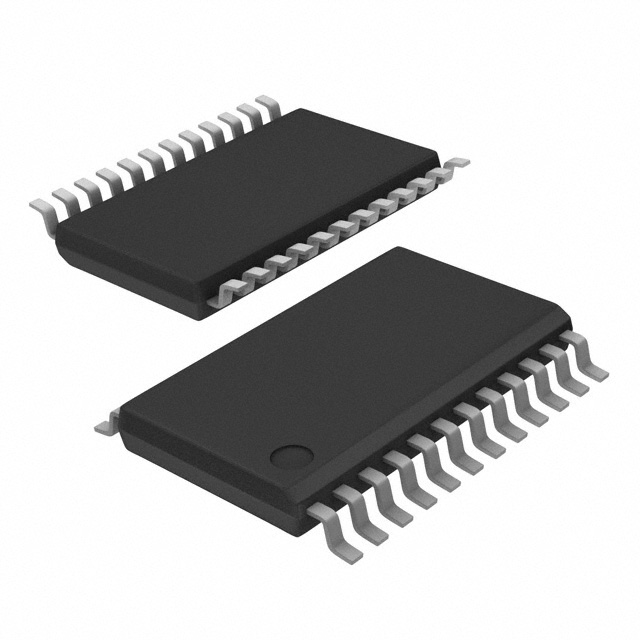Viz Specifikace pro podrobnosti o produktu.

SN74ABT646APW
Product Overview
Category
SN74ABT646APW belongs to the category of integrated circuits (ICs).
Use
This IC is commonly used for bus transceiver applications.
Characteristics
- High-speed, low-power CMOS technology
- Bidirectional data flow capability
- 3-state outputs for bus-oriented applications
- Schmitt-trigger inputs for noise immunity
- Available in a small package size
Package
SN74ABT646APW is available in a TSSOP (Thin Shrink Small Outline Package) package.
Essence
The essence of SN74ABT646APW lies in its ability to facilitate bidirectional data transfer between two buses with different voltage levels.
Packaging/Quantity
SN74ABT646APW is typically packaged in reels and comes in quantities of 2500 units per reel.
Specifications
- Supply Voltage: 4.5V to 5.5V
- Input Voltage Range: 0V to VCC
- Output Voltage Range: 0V to VCC
- Operating Temperature Range: -40°C to +85°C
- Propagation Delay Time: 6ns (max)
- Output Current: ±12mA
Detailed Pin Configuration
- OE (Output Enable)
- A1 (Bus A Data Inputs/Outputs)
- A2 (Bus A Data Inputs/Outputs)
- A3 (Bus A Data Inputs/Outputs)
- A4 (Bus A Data Inputs/Outputs)
- A5 (Bus A Data Inputs/Outputs)
- A6 (Bus A Data Inputs/Outputs)
- GND (Ground)
- B1 (Bus B Data Inputs/Outputs)
- B2 (Bus B Data Inputs/Outputs)
- B3 (Bus B Data Inputs/Outputs)
- B4 (Bus B Data Inputs/Outputs)
- B5 (Bus B Data Inputs/Outputs)
- B6 (Bus B Data Inputs/Outputs)
- VCC (Supply Voltage)
- DIR (Direction Control)
- OE (Output Enable)
- A7 (Bus A Data Inputs/Outputs)
- A8 (Bus A Data Inputs/Outputs)
- A9 (Bus A Data Inputs/Outputs)
- A10 (Bus A Data Inputs/Outputs)
- A11 (Bus A Data Inputs/Outputs)
- A12 (Bus A Data Inputs/Outputs)
- GND (Ground)
- B7 (Bus B Data Inputs/Outputs)
- B8 (Bus B Data Inputs/Outputs)
- B9 (Bus B Data Inputs/Outputs)
- B10 (Bus B Data Inputs/Outputs)
- B11 (Bus B Data Inputs/Outputs)
- B12 (Bus B Data Inputs/Outputs)
- VCC (Supply Voltage)
Functional Features
- Bidirectional data transfer between two buses
- Output enable control for 3-state outputs
- Direction control for selecting the data flow direction
- Schmitt-trigger inputs for improved noise immunity
Advantages and Disadvantages
Advantages
- High-speed operation
- Low power consumption
- Noise-immune design
- Small package size
Disadvantages
- Limited voltage range (4.5V to 5.5V)
- Propagation delay may affect timing-sensitive applications
Working Principles
SN74ABT646APW operates by receiving data from one bus (A) and transmitting it to another bus (B), or vice versa, depending on the direction control signal. The output enable signal allows the IC to enter a high-impedance state, enabling multiple devices to share the same bus without interference.
Detailed Application Field Plans
SN74ABT646APW finds applications in various fields, including: 1. Data communication systems 2. Networking equipment 3. Industrial automation 4. Automotive electronics 5. Consumer electronics
Detailed and Complete Alternative Models
Some alternative models that can be considered as alternatives to SN74ABT646APW are: - SN74ABT646ADW - SN74ABT646ADB - SN74ABT646ANSR - SN74ABT646APWRG4 - SN74ABT646ADBR
These models offer similar functionality and characteristics, providing flexibility in choosing the most suitable option for specific applications.
Word count: 526 words
Seznam 10 běžných otázek a odpovědí souvisejících s aplikací SN74ABT646APW v technických řešeních
Sure! Here are 10 common questions and answers related to the application of SN74ABT646APW:
Q: What is SN74ABT646APW? A: SN74ABT646APW is a type of integrated circuit (IC) that functions as a bus transceiver with 3-state outputs.
Q: What is the purpose of SN74ABT646APW? A: The purpose of SN74ABT646APW is to enable bidirectional data transfer between two buses or systems with different voltage levels.
Q: What voltage levels does SN74ABT646APW support? A: SN74ABT646APW supports voltage levels ranging from 2.5V to 5.5V, making it compatible with a wide range of systems.
Q: How many bits can SN74ABT646APW handle? A: SN74ABT646APW can handle 8-bit or 16-bit data transfers, depending on the configuration.
Q: Can SN74ABT646APW be used in both parallel and serial communication systems? A: Yes, SN74ABT646APW can be used in both parallel and serial communication systems, thanks to its bidirectional capabilities.
Q: Does SN74ABT646APW have any built-in protection features? A: Yes, SN74ABT646APW has built-in ESD (electrostatic discharge) protection, which helps safeguard against damage during handling or operation.
Q: Can SN74ABT646APW be used in high-speed applications? A: Yes, SN74ABT646APW is designed for high-speed operation and can support data rates up to 100 MHz.
Q: How does SN74ABT646APW handle bus contention? A: SN74ABT646APW uses a 3-state output, allowing it to disconnect from the bus when not actively transmitting or receiving data, thus avoiding bus contention.
Q: Can SN74ABT646APW be used in mixed-voltage level systems? A: Yes, SN74ABT646APW is suitable for mixed-voltage level systems as it provides voltage level translation between different buses.
Q: Are there any specific application notes or reference designs available for SN74ABT646APW? A: Yes, Texas Instruments (the manufacturer) provides application notes and reference designs that can help guide the implementation of SN74ABT646APW in various technical solutions.
Please note that these answers are general and may vary depending on the specific requirements and use cases. It's always recommended to refer to the datasheet and documentation provided by the manufacturer for accurate information.

